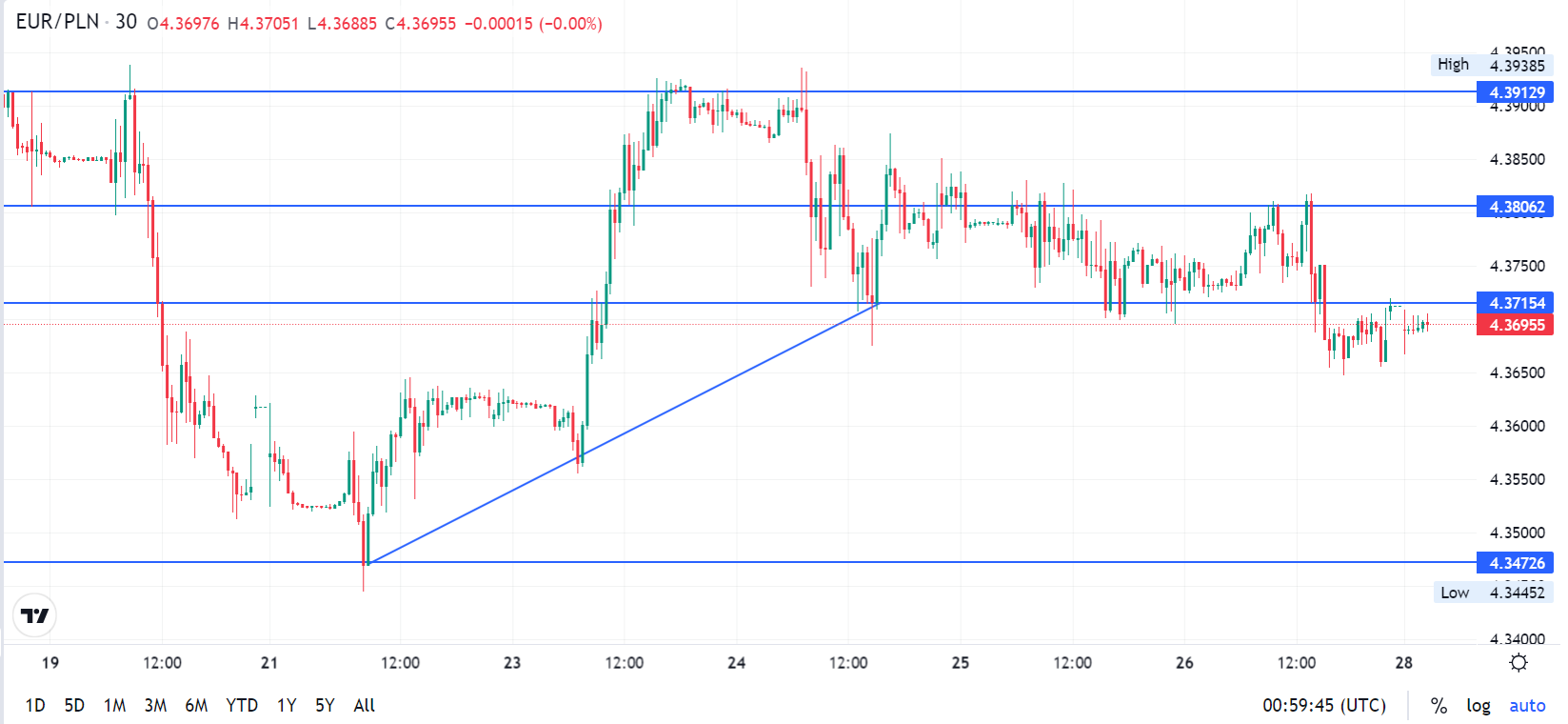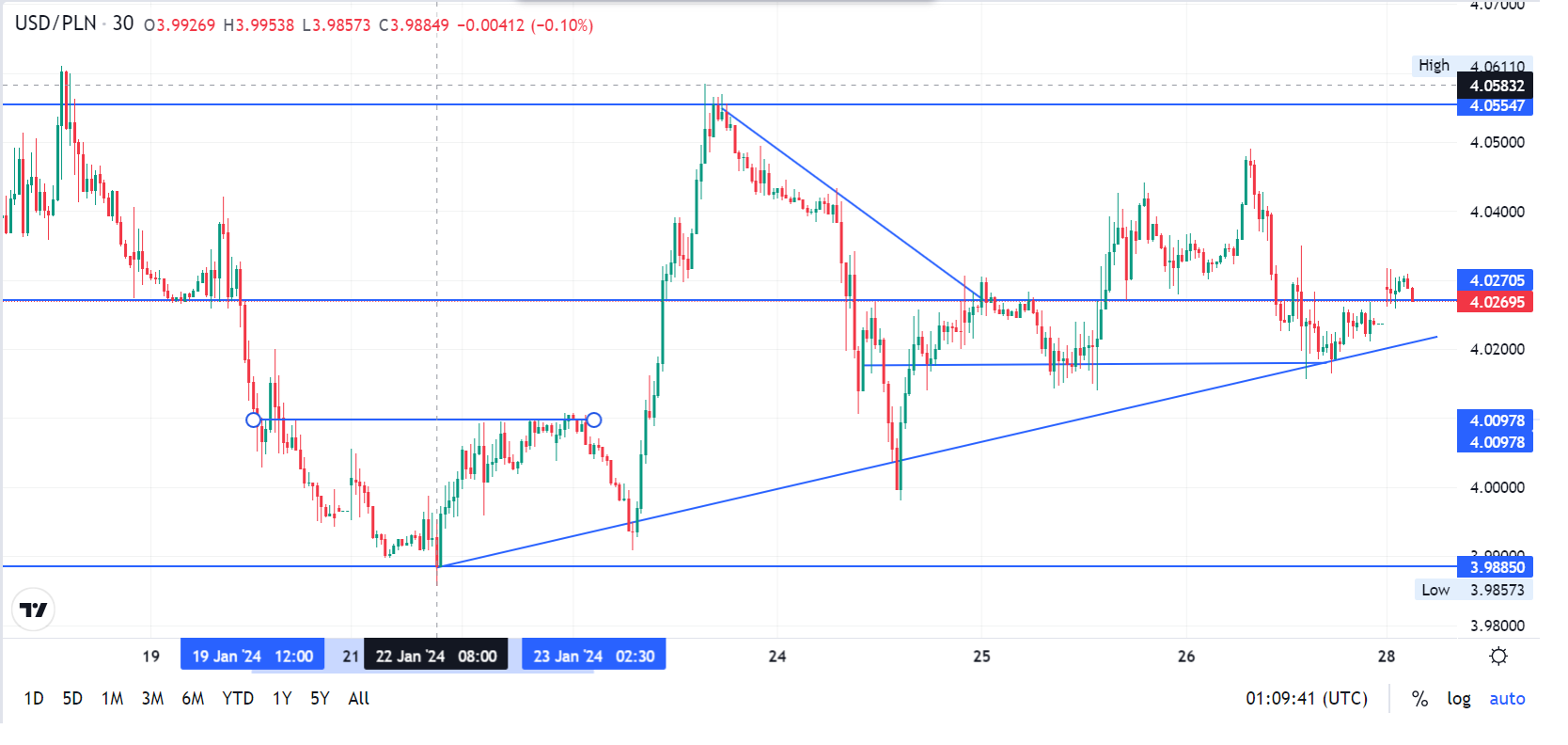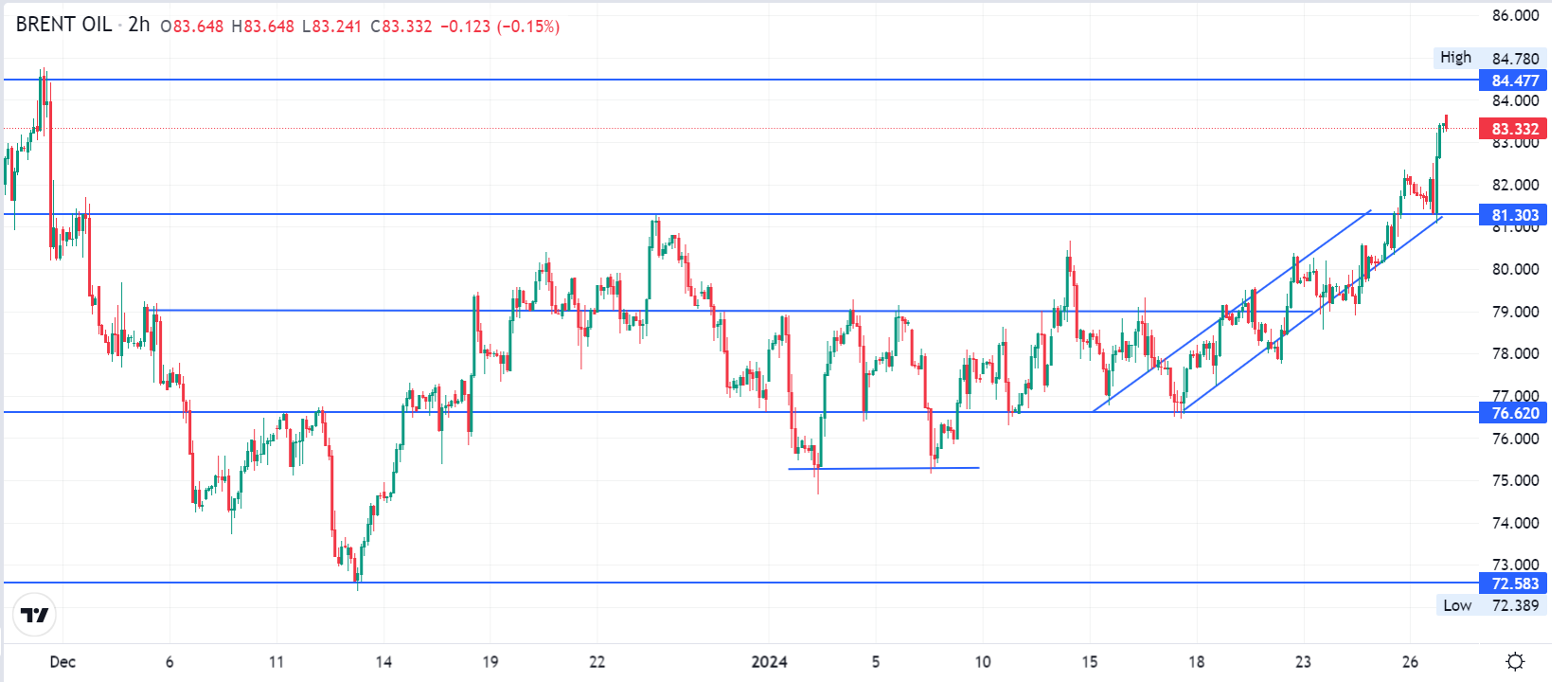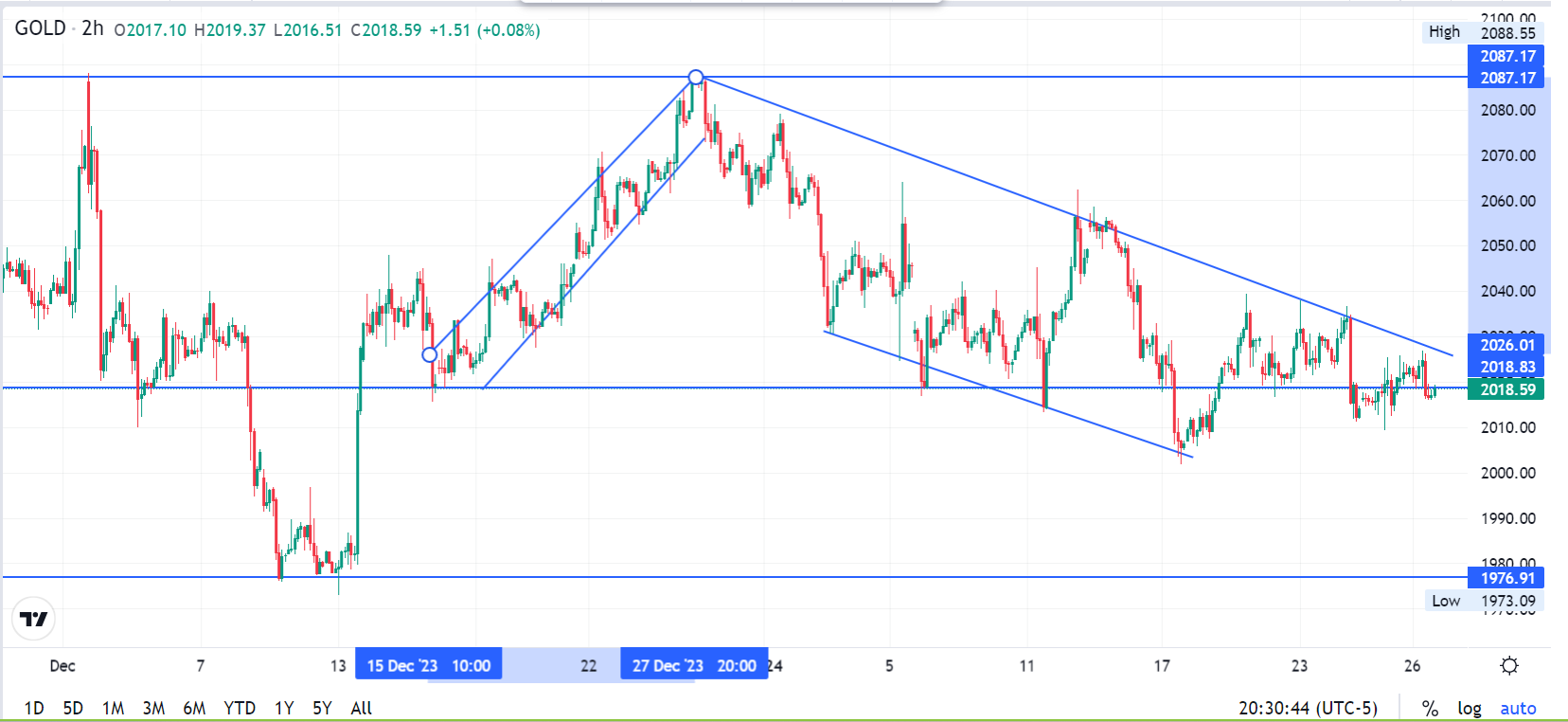Market Summary by AFORTI: record apartment prices in Poland, decline in retail sales in December and ECB interest rates
The last week in Poland was not full of information from the domestic market and the currency market reacted mainly to external factors. In Poland, as expected, the Senate accepted the budget voted by the Sejm during a two-day meeting. Let us remind you that the budget assumes a record budget of PLN 184 billion. This includes revenues of PLN 682 billion and expenses of PLN 866 billion. The finance sector deficit will amount to 5.1%. The next step is to submit the approved budget for signature by the President by the required date - by the end of January. Meeting this deadline means that shortening the term of office of Parliament and calling early elections is out of the question.
Among the few data from the Polish market, weak retail sales data in December certainly attracted attention. A decline of 2.3% y/y is a very poor result, showing that household demand is consistently slowing down. Similarly, industrial production data were negative. Annual declines of almost 4% and monthly declines of almost 10% are also not optimistic. For a change, the construction industry recorded strong growth - it increased by 14% y/y, and by an astonishing almost 29% on a monthly basis. This is undoubtedly the result of cheap loans (including the government's 2% program). Strong interest in purchasing new apartments obviously translates into a sharp increase in prices. Until recently, the price of PLN 15,000/m2 in Warsaw seemed to be a ceiling that would not be surpassed. Recent investments are carried out at around PLN 20,000 and even PLN 24,000/m2 in locations that are not considered prestigious at all. This, of course, raises questions about whether the price bubble will burst - as is the case on the German market, for example.
Looking at the information from the European market - the markets were waiting for the ECB's decision on interest rates. The bank, in line with investors' expectations, behaved very predictably and the reference rate remained at 4.5% and the deposit rate at 4%. The conference of the head of the ECB, Christine Lagarde, did not bring clear declarations regarding changes in interest rates, but it could be concluded that the second half of 2024 may bring a series of cuts that may amount to 125-150 basis points. If this were to be spread over 6 months of 2024, this means either cuts of 25 points each month or larger moves of 50 points each. In our opinion, the first cuts in interest rates may take place as early as May or June - with a conservative approach and a reduction of 25 points. Subsequent conferences will certainly be important, as they should provide more transparent signals to financial markets.
The ECB will try not to stifle the awakening European economy. Although it is difficult to talk about a sharp rebound, the first signals from the PMI readings for manufacturing - where the readings increased from 44.4 to 46.6 and the decreasing declines in production - give hope that the EU economy is starting to regain vigor. It is true that the PMI for consumption and services was slightly weaker than a month earlier and dropped from 48.8 to 48.4, but falling interest rates may soon reverse the trend and "pull" the index above the psychological value of 50.
For a change, the American economy shows that record reference rates of 5.25-5.50% did not cause a significant cooling, but on the contrary - GDP growth from 1.9% in 2022 to 2.5% in 2023 means that the US economy is doing quite well. The last quarter saw GDP growth to 3.3%, which surprised virtually all analysts who expected a much lower reading. Data on new registered unemployed also remain at historically low levels of around 200,000.
As can be seen in the comparison with the EU economy, the United States coped significantly better with inflation and defending the economy against recession. Against this background, the German economy is performing very poorly, as it has been short of breath for a long time and we have maintained the level of GDP growth. In this context, European stock markets are also performing worse, while Wall Street is extremely optimistic. This is also related to the expected good data of the largest 7 companies listed on the American stock exchange. These 7 companies constitute 25% of the capitalization of the S&P500 list. These include companies known to everyone: Alphabet (Google), Microsoft, Apple, Amazon and Meta (Facebook). The publication of good data is a strong signal for investors and maintains the bullish climate.
On Wednesday, January 31, investors' eyes will be on the Fed. However, here too - similarly to the ECB - we do not expect any surprise and interest rates will most likely remain unchanged. The announcement will be important as it may shed more light on whether a cycle of interest rate cuts will begin at the beginning of the second quarter. According to our expectations, we should see the first of 2-3 cuts of 25 basis points in April or May.
When looking at the largest economies, it is worth looking at Asia. The Chinese economy is clearly facing the good situation in the US and, in order to stabilize the situation and GDP growth, it is looking for support for its financial markets. One of the decisions will be to reduce the mandatory reserve rate by 50 points. This is a strong signal, which will be additionally supported by the decision to use over USD 280 billion from the accounts of state-controlled companies to fund the Chinese stock exchange. Will this be enough to sustain over 5% GDP growth? Not necessarily. Given the accelerating American economy, this may be too small an injection to maintain the assumed growth rate.
As for our currency, we saw continued rapid fluctuations of the Polish zloty against all currencies. The calm and "range trading" assumed last week were again put under pressure, which was compounded by issues related to the weakening currencies of the Central European region and the weakening common currency. While two weeks ago the NBP was clearly active on the market, last week the zloty was clearly unstable due to increased movements generated by foreign investors.
This time, the zloty lost at times to the level of EUR/PLN 4.3900, and then the resistance moved down to EUR/PLN 4.3800 - which we indicated as the upper range of the corridor. Finally, we ended the week slightly below EUR/PLN 4.3700.
The question is how the zloty will react to the common currency next week. Considering that the last 2 weeks have been quite tense for the PLN, we can assume that the first half of the week may still be characterized by increased volatility. Moving the corridor slightly upwards should capture the EUR/PLN trade in the range of 4.3600-4.4000.
EUR/PLN over the last 7 days

Looking at the American currency, the dollar also gained strongly, moving by 7 cents from the minimum of USD/PLN 3.9980 to almost 4.0550. High volatility resulted from movements on EUR/USD, where the Euro was losing in recent days almost to the level of 1.0800.
Similarly to EUR/PLN, we also expect increased volatility here, and the zloty is likely to remain above the psychological value of USD/PLN 4.0000. In our opinion, USD/PLN will trade in the USD/PLN range of 4.0000-4.0400
USD/PLN over the last 7 days

The above-mentioned EUR/USD quotations corrected to even 1.0800 from the initial levels this month of above EUR/USD 1.1000. The dollar was gaining due to the above-mentioned macroeconomic data readings, which were better than those in Europe. Currently, we do not expect that there will be a strong break above the resistance at EUR/USD 1.0950, but rather we will observe levels closer to EUR/USD 1.0800-1.0850
EUR/USD over the last 7 days

A brief look at the commodity markets - especially BRENT crude oil. Price turmoil is invariably caused by the prolonged conflict in the Gaza Strip and concerns about the conflict spreading to the region, but also by the conflict related to attacks on merchant ships passing through the Red Sea on the trade route through the Suez Canal. The bases of Houthi rebels attacking from Yemen were bombed by allied forces of the USA and Great Britain as part of the action of allied forces. This does not calm down the mood, and therefore oil prices return to the levels at the end of 2023 - i.e. USD 85-86/barrel.
BRENT crude oil – last month USD/barrel

Gold – still remains an attractive asset. Consolidation around the level of USD 2.020/ounce is visible. This means that investors still keep this precious metal in their portfolio - as a stable investment.

Finally, a short look at the stock markets. We saw increased optimism on global markets, which returned to the Polish stock exchange after the declines at the beginning of the year. After the correction to around 74,000, the WIG index gained almost 1,600 points - which may mean that the stock exchange will return to the upward trend. WIG 20 is gaining to a lesser extent and is currently 2,223 compared to 2,380 at the end of 2023.

Szymon Jańczak
Director of
the Treasury Department
AFORTI.BIZ

